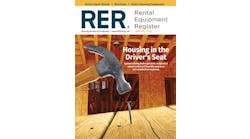The biggest mistake new rental company owners make when preparing a business plan is that they don't do one at all — a point that was repeated again and again during the interviews with lenders RER did for this article.
A business plan doesn't just show banks, investors and other lenders that the principles have done their homework. It also gives the principles the opportunity to carefully study the marketplace and the competition, and helps them make important decisions about how to shape the business.
Preparing a business plan sets a framework of goals for a new company, generally with a timeline of the first five years. Companies that stay attuned to that business plan long after the ink has dried on the checks from their financiers will be best prepared to stay on track and set their sights on growing the business into the future.
Here's what the experts — rental lenders and experienced rental people — say must be included in a business plan to help rental companies ensure financing.
Define the business.
Answer the who, what, when, where and how questions in detail. Who are the principle owners of the business and what experience do they have? What type of business is it? When will the doors open for business? Where will it be located — in what city and in what building? And how do the principles plan to get the financing necessary to get started?
According to Skip Evans, managing director, Evans, Waite Business Solutions in Centennial, Colo., and a former owner of a successful rental company, getting the attention of a lender is important. A good way to do that is to provide an executive summary on each of the principles involved in the new business. Provide a resume for each that outlines professional experience and expertise. Not only will this get the attention of a lender with a stack of business plans on his or her desk, but it may also be the key to getting approved for the needed financing.
“Management experience and know-how are always critical when presenting a business plan for the first time,” says Robert Mete, vice president of risk for GE Capital Solutions, Commercial Distribution Finance, St. Louis, Mo. “In my experience, this is a key difference between executing on the plan or not.”
Personal financial statements and personal credit reports are also important information to include for each of the principles. If this is their first business venture, then personal credit history is all a lender has to go on in determining risk, says Mike Arness, president of Ephrata, Wash.-based ClearView Financial.
Outline the financing options.
Different lenders have different requirements of their clients in terms of their personal investments, but most lenders want to see that at least 25 percent of the start-up capital is paid in by the principles. So, if it's going to take $1 million to start the company, at least $250,000 should be put in by the owners.
“There are not very many lenders who will take a risk on a company where the owners do not show a strong commitment via investment,” says Harry Schneider, president, Allied Financial Solutions, Florence, Ky.
What a lender or an investor wants to know, according to Gary Stansberry, partner in the mergers and acquisitions firm of Arlington, Texas, and Cameron Park, Calif.-based Hageman, Stansberry & Associates, is that you've got your house, your career and your personal financial future on the line and it's going to hurt you a lot more than it's going to hurt them if the business fails and the initial investments are lost.
According to Evans, the majority of people looking to get into the rental business are undercapitalized. “It's harder to get into the rental business today because margins are less. You have to be smarter; you can't make mistakes. Today, a big mistake could take you under,” he says.
As a result, business owners should be cautious when making decisions during the planning process and make sure they've done the research to determine exactly how much capital is needed, including that information in detail within the business plan, noting not only how much will be contributed by its principle owners, but also how much the owners are asking for from potential investors or lenders and who they are.
Lenders want to see that new business owners are diversifying the sources with which they are securing their money, says Tim Cetto, president of Pinnacle Business Finance, Tacoma, Wash.
“There are multiple channels of capital available to the rental store owner,” Cetto says. “You've got manufacturer pricing, you've got bank financing, you've got your own cash and you've got finance companies such as ours that know and understand the rental business.”
So use the business plan to show what kinds of financing terms the new company's vendors are willing to provide. Often equipment manufacturers will offer certain items on a 6-month, no-interest plan. They may also consider providing a few units on consignment. For instance, if the company buys five air compressors, the vendor may agree to give them two more on consignment or even on a re-rent basis. This scenario allows the new company to have additional inventory without as much of an initial investment. The new company can work a rental split on the extra units, sometimes even pioneering a certain type of product to determine if it will be successful in its marketplace.
“You can start out with one on re-rent to see if it's actually going to rent, and establish a demand for that product,” says Stansberry.
Create a start-up balance sheet that outlines all financial goals and expenses.
Once the business owners have outlined where the start-up capital is coming from, they need to show how the money will be put to use, and when the new business will start making a profit. The more details the principles provide about all the financial requirements and goals of the business through the first five years, the better.
Stansberry recommends determining monthly cash flow requirements for the first two years after start-up, and then annual cash flow requirements for the first five years of business. Cash flow budgets are important to include in the business plan, he says, because they show lenders how much cash a new business will have available to operate during those first few lean months before accounts receivable start rolling in. They also help demonstrate how a company will fare in particularly seasonal climates.
Next, the business plan should break down what the start-up expenses will be. This includes leasing the building and renovating it; purchasing shop equipment, office furniture, computers, pick-up trucks, trailers and delivery vehicles; and hiring employees such as a manager and a mechanic to help get the business ready to open.
“I frequently see this as an area where people underestimate,” Stansberry says. “You can make a laundry list of things and then as you're going through it there's 10 other things that you never even thought of. Start-up costs are often hard to estimate. Leave a large cushion for miscellaneous or unanticipated expenses.”
Pinnacle's Cetto says it's the fixed expenses that he looks for to be outlined in a business plan. “Do they have the liquidity to be able to take care of their fixed expenses for a period of time if their equipment doesn't go out on rent? That's what I try to garner out of a business plan.”
Next, include a capital expenditure budget for both rental and non-rental equipment. Stansberry recommends that this budget be done on a month-by-month basis for the first two years of operation, including a timeline for achieving certain benchmarks. For example, the company may determine that when it reaches $100,000 a month in revenue, then it will need to spend another $500,000 in equipment. The company should also note in what month they expect that to occur, Stansberry says.
“The banks like to see that they're going to get paid first and you get paid second.”
GE Capital Solutions' Mete, also recommends including a timeline for key performance measures because they allow the principles to judge whether their business plan is working.
“It is nice to know that a company is focused on certain financial ratios such as EBITDA, leverage and asset utilization as much as the lender is concerned with them,” says Mete. The actual numbers, however, are not as important as the reasons and assumptions behind the numbers, he adds. The business plan should also include things such as a big bid that the company has won or is expecting to win, any big events or jobs coming to the area, or any new initiatives the company plans to focus on in the coming year. According to Mete, providing detailed financial plans gives lenders more confidence in management's abilities to manage through different economic cycles.
“For deals that have not made it, it was quite clear to us in many instances that the financial know-how and planning capabilities were lacking,” Mete says. “In my experience, having this ability is a competitive advantage and could result in long-term viability.”
Lastly, detail what your payroll will be including your owners' compensation.
“Banks and investors really look at this to see what an owner is going to put into this, not only capital-wise, but what sacrifices are they willing to make,” Stansberry says.
“A good detailing of expenses shows the underwriters that you have thought this through and aren't just going to throw it against the wall and hope it sticks,” says Arness.
Address the competition.
New business owners really can't know too much information about their competition. Detailing it in the business plan shows lenders that the owners have both done their research on the market and have thought about what competitive advantages they can offer over the competitors in that market.
First, define the size of the new company's competitive market. According to Nick Mavrick,vice president of marketing and sales for Asheville, N.C.-based Volvo Rents, banks want to see that there's fundamental, steady growth in the marketplace.
Then, go through and identify each of the competitive players in that market, including what types of equipment they specialize in, who their customer base is and what type of services they provide.
“You should research all rental yards that are close enough to be a competitor,” says Arness. “You should know what they rent, who they cater to and what their rental rates are. To beat your competition, you must know them first.”
Schneider agrees, noting that a new company's success is not just predicated on its abilities, but also by the knowledge its principles have of the competition going in. “If you don't learn as much as possible about them, you will enter the challenge at a slight or major disadvantage,” he says.
Find the market or service niche that the big rental companies in the area don't want to serve, suggests Evans. Then detail what the new company's competitive position is going to be — what is the niche it will serve and what is the marketing plan? If there are gaps in the marketplace that no one else is covering; if there's a specific type of equipment the company will specialize in; or if the principles of the business have an existing book of business that they plan to bring over from an existing company, explain all of those things.
Define your role in the market, says Stansberry. “If it's a $10-million market, how do you plan to get your marketshare and where is your revenue going to come from?”
Mike Melthratter, president and co-owner of Sacramento, Calif.-based American Scissor Lift, stresses the importance of knowing what the new business has to offer in its marketplace. “A small guy can't just jump into the market and start acting like one of the big guys,” says Melthratter. “That's a huge mistake and I've seen it happen before.”
Identify assets.
Lenders like to see that the principles have done some research on what types and sizes of equipment they're planning to buy, how much that equipment will cost, and how they plan to pay for it.
Stansberry recommends creating an Excel-type spreadsheet that includes a line for each individual type and size of equipment that will be in the new company's fleet. For example, there would be a line for 185 cfm air compressors, 360 cfm air compressors, and 40-foot booms. Then, it would also include how much each item costs, how many of each is needed for the start-up fleet, how many of that item the owners expect to add in 3 months, 6 months and in a year.
“I don't think you can go to the bank and say ‘I'm buying a million bucks worth of rental equipment,’ explains Stansberry. “They want to see in detail that you've done your homework because that detail gives you credibility, and shows that you're not just pulling figures out of the air.”
In its business planning sessions, Volvo Rents also breaks down projected equipment utilization and dollar utilization for each asset class, so that goals are established for each and every type of equipment, whether it's a skid-steer loader, a backhoe, a mini-excavator, a pump or a compressor.
“That's important because the business plan is exactly that, it's a working plan, and we utilize it to manage the lifecycle of rental assets, so if a piece of equipment is exceeding our expectations, then you want to go buy more and if it's not — if it hasn't met expectations — then we'll dispose of it,” says Mavrick. “Equipment rental's successful owners really look at their equipment assets as if they're a portfolio — so you sell one stock and buy another.”
Keep the plan alive.
A lot of what makes up a business plan are guesstimates and predictions. For that reason, it's a good idea for the business owners to review their plan every 12 to 24 months. Changes in the marketplace, the economy and the weather can have a significant impact on an original business plan and much of its financial goals and benchmarks. Updating the plan to reflect these changes will help the owners stay on track with meeting financial goals and will keep lenders satisfied that the owners are making the necessary adjustments to keep up with their financial responsibilities.
“You may have opened up your store in southern Louisiana right after Hurricane Katrina, and you had a completely different set of business criteria than you have now,” says Brian Bradley, franchise business planning manager for Volvo Rents. “You need to ask yourself if this model is going to carry you forward. Do you need to change from demolition-type equipment to aerial equipment or paving equipment? That's what your business plan helps you do and that's what your lenders are going to want to know.”
GE Capital Solutions' Mete compares the business plan to a roadmap. “If you have a roadmap and make a wrong turn, you can correct the action immediately to get back on the right road. Without a map, you could drive for a while and not know you are lost. A business plan allows us to keep looking forward and adjusting as we go.”
Allied Financial Solutions' Schneider advises business owners to never become apathetic to their business. He suggests taking time every month to look and compare the company's results to the projections; to spend time each year researching the territory again; and looking at changes that have occurred with the competition and with the customer base.
Business plan, part two.
If a rental company's owners are looking to expand to a second branch or to add a major line of new equipment, is a new business plan necessary?
According to American Scissor Lift's Melthratter, a whole new business plan wasn't necessary when he opened a new branch in Stockton, Calif., in 2004. Since the bank was already familiar with his business at its existing locations, Melthratter just needed to provide financial forecasts for the new location.
Evans suggests that companies interested in opening an additional location should prepare a plan that includes budget forecasts, inventory information and details about staffing requirements.
“I've seen in the past where somebody started a second location and they hadn't thought the whole process through first,” Evans says. “What they ended up doing was just spreading out their resources and increasing their overhead without really adding anything to the existing business.”
If creating a business plan seems daunting or too intimidating, solicit help from a professional, but the more involved the principles are in the planning process, the more knowledge they'll have about their company and its competition when the doors open for business.
“Most untrained people will not know what will or will not impress the underwriter,” says Arness. “Be conservative. We can spot ridiculous predictions quickly. We feel better that the plan will work, if you are a little heavy on the expense side, and a little light on the income side.”
Stansberry echoes those thoughts. “Be conservative. Under promise to your lenders, investors and yourself, and over-deliver on your results.”





